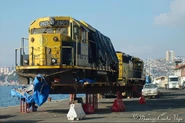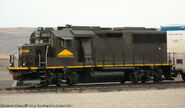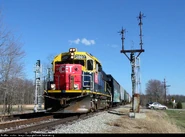The EMD (Electro Motive Division) GP49 is a type of four-axle, 12-cylinder, 2,800hp diesel locomotive built between 1983 to 1985 with only 9 built specially for the Alaska Railroad (ARR).

Newly-built ARR 2801 and 2802 awaiting delivery by ferry in Tacoma, WA.
Although a six-axle SD49 was offered in EMD's catalog, the model saw no orders and remained merely as a concept.
The 710-powered GP59 replaced the model beginning 1985.
History[]
The 1980's began a transitional period for EMD. Gone were the days of pure DC electrical systems and the earlier "Dash 2" circuitry found on increasingly-successful models like the SD40-2. In place of said systems were computer circuit boards part of microprocessor control schematics intended to improve and modernize the performance of a diesel-electric locomotive. In an attempt to attract more customers to the otherwise unpopular 12-cylinder, turbocharged GP39-2 (which sold a mere 239 units in contrast to the roots-blown GP38-2 and it's more powerful 16-cylinder counter-part: the GP40-2) , EMD launched a batch of GP39X testbeds in November 1980 as part of their "50 Series" line alongside existing earlier testbeds like the GP40X and "gen 2" SD40X. What was initially intended as the successor to the GP39-2 came an unpleasant result with the builder, for the model saw no orders from any Class 1 railroads during the brief 2-year production span in which the model was built. Only one taker, the Alaska Railroad, sought interest in acquiring four units (ARR 2801-2804) built in 1983, and five more (ARR 2805-2809) in 1985. As a result of the plagued performance statistics regarding the SD50 and subsequent GP50 during the time of their production (apart from the recession at the time), the popularity of the GP49 dwindled. Further avoiding risks with the otherwise problematic 50 Series models, railroads preferred ordering the more reliable and successful GP39-2, for the model saw more orders until 1984; a solid year before the 50 Series line was discontinued.
Five were retired and auctioned off to Helm Leasing (HLCX) in 2006, while the remaining four followed in 2008 to National Railway Equipment (NRE), where they remained in storage and served as lease power until two (2805 and 2808) were acquired and exported to Chile for Ferronor SA and were rebuilt into what are essentially dubbed as "SD49's". The other three (2803, 2806, and 2807) from the first batch were soon sold to Ohio-based shortline Cincinnati East Terminal Railway (CCET) upon the company's creation in 2014. The remainder from the second batch (2802 and 2809) were sold to Frontier Rail in 2009 following the subsequent auction. Despite having been leased to Frontier Rail of Washington for several months following the auction, ARR 2809 was eventually sold to Lake Railroad of Oregon.
GP39X[]
In November 1980, EMD built six 2,600hp GP39X testbeds as part of their program to develop a 50 Series

SOU 4600: one of six GP39X testbeds built in 1980.
successor to the preceding GP39-2. Similar in appearance to the GP50 but with a shorter frame, carbody, and built with two radiator fans as opposed to three, the GP39X prototypes were built to Southern Railroad (SOU) specifications. Configured with traditional high-short hoods ("high-hoods") set up for "long-hood-forward" operations, SOU 4600-4605 were painted and lettered for the railroad, but were actually owned by EMD under lease contract. The GP49 was soon added to the 50 Series lineup in EMD's catalog as a 2,800hp model, and the SOU units were eventually upgraded to GP49 specs years before having been retired and sold to Florida-based Tri-Rail and rebuilt as "GP49PH-3's" (equipped with updated controls and fitted with HEP generators), where they continue to operate in push-pull commuter service.
SD49[]
Two ex-ARR units (2805 and 2808) were rebuilt into what are essentially dubbed as "SD49's", despite none having been built during the proposed model's catalog entry. Both units currently serve in yard and local service alongside rebuilt GE U9C slug mates in Chile for Ferronor SA.
Specifications[]
| Model | GP39X | GP49 |
|---|---|---|
| Production Dates | 1980 | 1983-1985 |
| Total Built | 6 | 9 |
| Length | 59' 2" | 59' 2" |
| Wheel Arrangement | B-B | B-B |
| Engine | 12-645E3 | 12-645F3B |
| Aspiration | Turbocharged | Turbocharged |
| Horsepower | 2,600 | 2,800 |
| Alternator | AR15 |
AR15 |
| Traction Motors | D87 | D87 |
| Weight x 1,000lbs. | 269,000 | 250,000 |
Trivia/Facts[]
All nine original units built and delivered to the ARR were built to the road's specifications: having L-shaped windshields, snow shields, hood-top snow baffles, a second set of rooftop-mounted headlights, and winterization hatches over their front radiator fans. The second batch of units were delivered with more distinct snowplows. Said units (being the CCET ones) still retain said equipment.
In the spring of 1984, EMD out-shopped 20 MKT GP39-2 units built to GP49 specs. The units were essentially GP39-2's built with GP49 carbodies to house the internal machinery. Said units are still in service with Union Pacific (UP), though some have been retired. One notable flaw with the GP49 was the otherwise slow acceleration speeds. Although it was marketed as a mid-range, heavy-duty, high-speed road switcher, it took too long to get to top speed (which was a common complaint from Alaska Railroad crews). However, it has now been repurposed for slow traffic speeds, for shorelines have found it to be ideal for switching and slow-speed operations as opposed to what it was intially intended for.
Gallery[]
Sources[]
http://www.amazon.com/Locomotives-Modern-Diesel-Electric-Reference/dp/1554078962
http://www.alaskarails.org/pix/former-loco/eng-drwgs/2801-4.jpg












